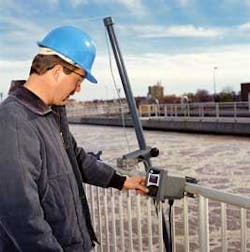By Brad Shannon
One of the oldest and largest facilities for Bristol-Myers Squibb (BMS), a global pharmaceutical and health care company, was built in 1943 in East Syracuse, NY, when BMS was one of 12 companies chosen by the federal government to mass produce penicillin.
The site employs about 800 people on a 90-acre campus with 1.7 million square feet of office, laboratory and manufacturing space. Here, BMS develops new medicines in state-of-the-art pilot plants, and manufactures a bulk active antibiotic that's the active ingredient in penicillin. This large-volume fermentation facility is the only U.S. plant of its kind.
After six decades, the manufacturing facility finds itself basically in the midst of a residential neighborhood. Because of this, BMS is particularly sensitive to neighbors' concerns and takes extraordinary measures to ensure its processes work as effectively and efficiently as possible. One particular area of concern is the facility's wastewater treatment plant, including odor control and abatement.
Until recently, BMS sacrificed energy efficiency to ensure its treatment system met or exceeded target levels of dissolved oxygen (DO) in its aeration system. Today, thanks to 24/7 monitoring using Hach's on-line LDO® (luminescent dissolved oxygen) technology, operators can monitor the system much more closely, and respond to changes in the wastewater stream almost instantaneously. Improved accuracy allows the system to operate more efficiently in an automatic operation mode vs. the manual mode previously employed. This has resulted in tremendous savings in energy costs, along with increased assurance that odor is under control.
Treatment Process
BMS outsources operation of its wastewater treatment process to Cunningham Environmental Support Inc., a business unit of Fairfield, NJ-based Covanta Energy Corp. Cunningham's Dean Merritt, wastewater treatment plant supervisor, works with nine employees to run the facility. They're supervised by BMS facility manager Dave Dombrosky. The team staffs the plant round the clock, monitors its operation, makes process decisions and ensures effluent meets discharge permit standards.
This pretreatment facility processes 1.2 mgd of waste, passing it on to the Syracuse Wastewater Treatment Plant.
"We produce a very high-quality effluent," Merritt said. "Our effluent quality meets standards needed to discharge directly to the environment, but there are no bodies of water nearby to enable us to do that."
The system has four aeration tanks, holding 8.2 million gallons. Three operate at a time, and one is in a denitrification cycle on a four-hour rotating basis. To aerate the tanks, the system uses a coarse air aeration system in the bottom of the tanks, driven by seven 200-hp positive displacement blowers for the smaller tanks, and four 300-hp centrifugal blowers for the larger tank.
Each tank is covered by a large dome, and the air that comes up through the process is treated as part of the odor control and abatement process. That system is driven by four 100-hp fans and a 75-hp fan to pull air through odor scrubbers. The scrubbers consist of packed media in towers, where the air is exposed to a hypochlorite and caustic solution to oxidize and remove any hydrogen sulfide it contains.
Treatment Challenges
The high concentration of waste, as measured by chemical oxygen demand (COD), is the biggest challenge. Generally, municipal plants have influents in the 300 mg/L range for COD. BMS influent waste is primarily fermentation products from manufacturing that average about 7,000 mg/L COD. As a result, retention time required to treat the waste is substantially longer – four days, or 96 hours, rather than 12 to 18 hours typically required at a municipal plant. The additional retention time allows the waste to be aerated more effectively to meet target effluent COD limits.
Until 2003, the aeration tanks' DO levels were measured manually using a handheld meter. If DO results were too low, another blower was turned on to send more air through the aeration tanks and raise the DO reading – and vice versa. This was an effective but inefficient approach to making sure effluent quality met standards. One problem was the aeration blowers were either on or off – running at full speed, or completely idle – resulting in significantly higher costs to pay for wasted energy and increased maintenance and downtime.
A separate problem was that because DO levels were only checked periodically, operators didn't know if the latest reading was persistent and steady over an extended time, or if it reflected conditions that occurred just before the test was conducted, only to quickly change again just after the sample was taken.
"To ensure we were handing off quality effluent, we ran the system at the higher edge of the curve, typically over-aerating just to be safe," said Dombrosky. "As a result, we were wasting the energy equivalent of one blower."
Seeking Better Efficiency
Operators were trying to find a way to upgrade the aeration process to improve its efficiency. With on-line equipment to measure DO and call attention to any problematic readings, they would be able to measure more accurately and consistently, and reduce unnecessary use of additional blowers.
Variable frequency drives: The ideal solution the team envisioned was to tie precise on-line DO monitoring to a blower control system that adjusted aeration in response to DO measurements. Using variable frequency drives (VFDs) to power the blowers meant that, if DO readings indicated the process needed adjusting in aeration, a VFD could be used to provide just the right amount.
Higher temperature readings: When Hach introduced the LDO meter, which features breakthrough technology for measuring dissolved oxygen, operators were suddenly on the verge of substantially improving process efficiency. Because the maximum operating temperature range of the LDO probe tops out at 122°F, well above the actual process temperature of 112°F, it solved the primary problem that delayed the system upgrade. Not only did this new system eliminate the tedious and inconsistent manual DO testing process, it greatly reduced the need for cleaning and maintenance in comparison to other on-line DO monitors.
"Automating was something we always wanted to do," Merritt said, "but we were limited by the operating temperature ranges of the DO monitors on the market. The technology was just not available to allow us to do continuous monitoring."
The LDO system uses a sensor coated with a luminescent material. Blue light from an LED is transmitted onto the sensor surface, exciting the material, which emits red light as it relaxes. The presence of DO in the process shortens the time it takes for the red light to be emitted. By measuring the time lapse between when the blue light was transmitted and the red light is emitted, a correlation is made to DO concentration in the effluent or other solution. Between measurements, a red LED is used as an internal reference.
The new system offers several advantages over previous DO measurement methods. Maintenance is greatly reduced, since there are no membranes, electrolyte solutions or anodes and cathodes – the sensor just needs to be wiped off periodically. The only replacement part is the sensor cap, which is inexpensive and simple to replace. The internal reference calibrates the instrument with every reading. And the sensor isn't affected by factors like pH, hydrogen sulfide, heavy metals or other chemicals, so the system produces stable, accurate measurements over an extended period of time. Pole mount or ball-float mount kits let users place the analyzer wherever it's needed.
System Upgrade
Merritt and Dombrosky learned about the LDO system from a company representative, and immediately realized the benefits the new technology offered and how they could leverage it. They decided to use the system on a three-month trial to gather data and gauge the potential return on investment from eliminating manual sampling to monitor DO and reducing energy costs to drive aeration blowers.
"We needed to show management that a substantial investment to fund the major cost of the upgrade – the variable frequency drives for the blowers – would pay for itself in a reasonable time," said Dombrosky.
The trial demonstrated the potential savings of upgrading the system. The total project cost, including the LDO analyzers, VFDs and installation labor, was about $65,000. The estimated payback period for the system was less than a year.
Now, BMS's totally automated system is driven by LDO meters on all four aeration tanks. Operators know exactly what DO levels are in the tanks 24/7. DO readings are fed to a programmable logic controller (PLC) and, when a reading indicates a need for more aeration in one of the tanks, the PLC speeds up one of the blowers for that tank. Rather than wasting energy by turning on a blower at full speed, the VFDs provide just the right amount of additional aeration to bring the DO level in line.
"Certainly there was a cost factor, as we needed to purchase the meters and put VFDs on the blowers," said Merritt. "But the savings and control we've realized as a result have been tremendous. We set the system to maintain 2 ppm DO, and forget it. The LDO meter feeds the PLC a reading, and the PLC speeds up or slows down the blowers to maintain 2 ppm DO. The DO measurements are constant, repeatable and reliable, and the system is enormously more effective and efficient than our old approach."
Calculating the Payoff
The energy savings directly attributable to the use of LDO meters to continuously monitor DO, feed that information to PLCs and have the PLCs drive the aeration blowers using VFDs in response to DO readings are startling. On each aeration tank, BMS save $24,000/year in energy costs. With three tanks in operation at any time, the system realizes savings of $72,000/year in energy costs alone, significant for a facility with energy costs of $1 million/year.
"That means, just calculating energy savings, we will have payback in less than a year for the entire system," said Dombrosky. "That includes the cost of the meters, the VFDs and the labor to install everything."
In addition, operators also had instant notification of problems or upsets in the system. Overall labor, maintenance and supplies were reduced substantially, since manual testing was eliminated and the VFDs eased the blowers' workload. By eliminating over-aeration, the load on the scrubbers used to treat the air as part of the odor control and abatement process was reduced by 25%, saving more energy, labor, supplies and maintenance costs.
Conclusion
In addition to monetary gains, perhaps the biggest benefits likely realized are the most difficult to measure: operator peace of mind, knowing the process is under precise control.
"Before, if we got a DO level that was out of line, we would turn a blower on," Merritt said. "Because we didn't want to take any chances, we wasted air and energy. Now, we always know what's going on with the system, and we use the appropriate amount of energy and air to keep it in control, automatically."
The team also strengthened its partnership with the area municipal wastewater treatment plant, which can count on receiving a consistently high-quality effluent from BMS. And while many may not realize it, BMS's neighbors can trust the company will go out of its way to ensure it continues to be a good neighbor, seeking out new technology to improve its operations and help protect their environment.
About the Author:
Brad Shannon is a freelance writer of Hach Company, of Loveland, CO. Hach provides advanced analytical systems and technical support for water quality testing, with solutions for lab, process and field uses. Hach can be contacted at 800-227-4224, www.hach.com or email: [email protected].


